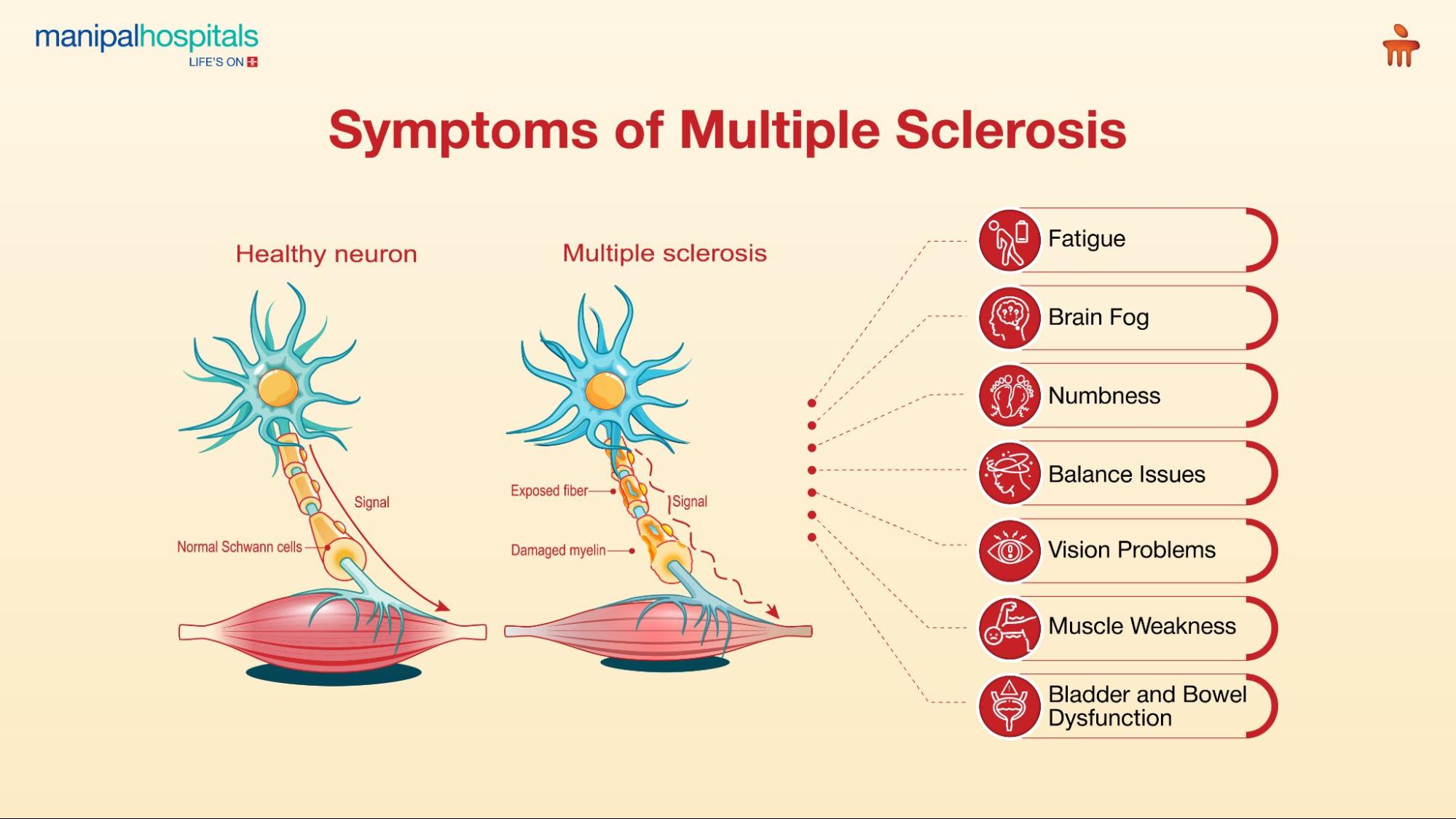
Multiple Sclerosis (MS) is a chronic autoimmune disease of the central nervous system that affects millions of people worldwide. In this condition, the body’s immune system mistakenly attacks the myelin sheath, the protective layer of nerve fibres. This disrupts the flow of information between the brain and the rest of the body. Eventually, the condition can permanently damage the nerve fibres.
MS is an extremely debilitating and unpredictable condition owing to its variability in symptoms. While there's no cure for multiple sclerosis, there are treatments to help recover from attacks and manage symptoms.
Synopsis
Causes of Multiple Sclerosis
Despite extensive research, the causes of MS remain largely unknown. However, genetic predisposition and environmental factors are some of the common multiple sclerosis. While MS is not directly inherited, having a close relative with the disease slightly increases the risk.
Several environmental factors that could cause MS include:
-
Vitamin D Deficiency: Studies have linked lower levels of vitamin D to a higher risk of developing MS.
-
Epstein-Barr Virus (EBV) Infection: MS is often a common complication of an EBV infection.
-
Smoking: Smoking not only increases the risk of developing MS but also accelerates disease progression.
-
Obesity: Obesity, especially during adolescence, has been associated with an increased risk of MS.
It's important to note that while these factors may increase susceptibility, they do not guarantee the development of MS. Many individuals with MS may not even have any of these risk factors. The underlying mechanism involves an exaggerated immune response that targets the myelin covering of the nerve fibres within the brain and spinal cord.
Symptoms of Multiple Sclerosis
Multiple Sclerosis symptoms vary from one person to another, both in type and severity, and can even fluctuate over time. This variability often makes early diagnosis challenging. Common symptoms include:

-
Fatigue: One of the most debilitating symptoms, patients with MS describe it as an overwhelming exhaustion that is not relieved by rest.
-
Numbness or Tingling: Sensations of pins and needles, or a loss of sensation, can occur in the face, body, or limbs.
-
Vision Problems: Blurred vision, double vision, or eye pain due to inflammation of the optic nerve (optic neuritis) are common early symptoms.
-
Muscle Weakness or Spasticity: Patients with MS often experience weakness in the limbs, difficulty with coordination, and muscle stiffness or spasms.
-
Balance and Coordination Problems: Dizziness, vertigo, and ataxia (unsteady gait) can significantly affect mobility.
-
Bladder and Bowel Dysfunction: Frequent urination, urgency, incontinence, or constipation can be challenging symptoms.
-
Cognitive Issues: Problems with memory, attention, information processing, and executive functions are common, often referred to as "brain fog."
-
Pain: Chronic pain, including neuropathic pain (nerve pain) and musculoskeletal pain, affects many individuals with MS.
-
Speech Difficulties (Dysarthria) and Swallowing Problems (Dysphagia): These occur as nerve damage affects muscles involved in speech and swallowing.
Symptoms can appear suddenly, worsen over days or weeks, and then partially or completely resolve (relapses), or they can progress gradually over time.
Types of Multiple Sclerosis
Types of MS are categorised based on their disease course and progression patterns:
-
Relapsing-Remitting MS (RRMS): This is the most common form, affecting about 85% of people with MS at diagnosis. This relapsing form of MS has clearly defined attacks (relapses) of new or worsening neurological symptoms, followed by periods of partial or complete recovery (remissions). During remissions, symptoms may disappear or significantly improve, although some residual deficits can remain.
-
Primary-Progressive MS (PPMS): Affecting approximately 15% of individuals, this type shows a gradual deterioration of neurological function from onset. The rate of progression can vary, but there are no periods of significant improvement.
-
Secondary-Progressive MS (SPMS): Many individuals initially diagnosed with RRMS will eventually transition to SPMS. In this form, the relapsing-remitting course is followed by a steady and continuous loss of neurological function.
-
Progressive-Relapsing MS (PRMS): This is the least common form, showing steady neurological decline from the onset, with acute attacks.
Diagnosing Multiple Sclerosis
A definitive multiple sclerosis diagnosis is a lengthy process because of how varied and inconsistent the symptoms are. There is no single multiple sclerosis test that confirms the disease. It involves the combination of clinical evaluation of the signs of MS and specialised investigations.
The McDonald Criteria, revised periodically, are the most widely used diagnostic guidelines. Key diagnostic tools include:
-
MRI (Magnetic Resonance Imaging): MRI scans of the brain and spinal cord can reveal the characteristic lesions or plaques (indicating loss of myelin sheath). The presence of lesions in different areas of the CNS and appearing at different times helps determine the diagnosis.
-
Evoked Potentials: These tests measure the electrical activity of the brain in response to sensory stimulation. This test can detect slowed nerve conduction due to myelin damage, even if there are no apparent symptoms.
-
Lumbar Puncture (Spinal Tap): Cerebrospinal fluid (CSF) can reveal unique proteins and elevated immunoglobulin G (IgG) levels, which indicate MS.
-
Blood Tests: While no blood test can diagnose MS, they can rule out other conditions that might mimic MS symptoms, such as Lyme disease, lupus, or vitamin B12 deficiency.
A thorough neurological examination, including assessing reflexes, coordination, balance, vision, and sensation, also plays a vital role in the diagnostic process. Consult expert neurologists in Ranchi today to get an accurate diagnosis and expert guidance.
Multiple Sclerosis Treatment
While there is currently no cure for MS, significant advancements in multiple sclerosis treatment have helped patients with MS manage their condition. Treatment options generally fall into two main categories:
-
Disease-Modifying Therapies (DMTs): These multiple sclerosis medications aim to reduce the frequency and severity of relapses. They also slow disease progression and decrease the accumulation of new lesions on MRI. DMTs work by modulating or suppressing the immune system, preventing it from attacking myelin. Doctors give these medications as injections, oral medicines or intravenous infusions.
-
Symptomatic Treatment: This multiple sclerosis therapy focuses on managing the specific neurological symptoms of MS that can significantly impact daily life. These symptoms can include fatigue, spasticity, pain, bladder dysfunction, cognitive impairment, depression, and vision problems. Symptomatic treatments can involve:
-
Medications: For pain, spasticity, fatigue, bladder issues, and depression.
-
Physical Therapy: To improve strength, balance, coordination, and mobility.
-
Occupational Therapy: To help individuals adapt to daily activities and maintain independence.
-
Speech Therapy: For speech and swallowing difficulties.
-
Cognitive Rehabilitation: To address memory and cognitive issues.
-
Psychological Counselling: To help manage the emotional impact of MS, including depression and anxiety.
Beyond pharmacological interventions, lifestyle management plays a crucial role in living well with MS. This includes maintaining a healthy diet, engaging in regular exercise adapted to individual abilities, managing stress, getting adequate sleep, and avoiding smoking. These choices can contribute to overall well-being and potentially reduce symptom severity. Visit the neurology department at Manipal Hospitals, Ranchi, for expert treatment.
Conclusion
While MS is a chronic and progressive condition, significant advancements in multiple sclerosis treatment have dramatically improved the quality of life for patients with MS.
The ongoing research into the causes and innovative treatment approaches for multiple sclerosis continues to offer immense hope. Scientists are actively investigating strategies for myelin sheath repair, nerve protection, and personalised medicine to tailor treatments based on the unique disease characteristics.
FAQ's
Multiple sclerosis can affect a person's daily life in various ways, from physical symptoms like fatigue and muscle weakness to cognitive issues such as memory problems. These symptoms can make routine tasks, work, and social activities more challenging and unpredictable.
Currently, there is no cure for multiple sclerosis. However, with modern treatments, it is now possible to manage the disease, reduce the frequency of relapses, and slow its progression, allowing many people to live full and active lives.
The main cause of multiple sclerosis is a complex combination of genetic and environmental factors that trigger the immune system to attack the central nervous system. While the exact trigger is still unknown, it is believed to involve a mix of genetic susceptibility, viral infections, and other environmental elements.
MS is not directly hereditary in the same way as conditions like cystic fibrosis; however, a genetic predisposition does exist. This means that while it is not passed down directly, certain genes can increase a person's susceptibility to developing the disease.
The seriousness of multiple sclerosis varies greatly from person to person, ranging from mild symptoms with little impact to severe disability. The disease can be serious because it is a lifelong, progressive condition that can lead to significant physical and cognitive challenges if left untreated.





















 9 Min Read
9 Min Read















